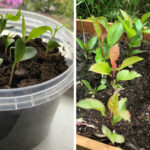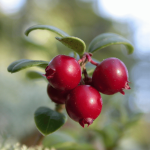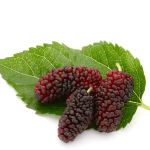Top 10 Berries and Fruits for Scandinavian Gardens: A Comprehensive Guide
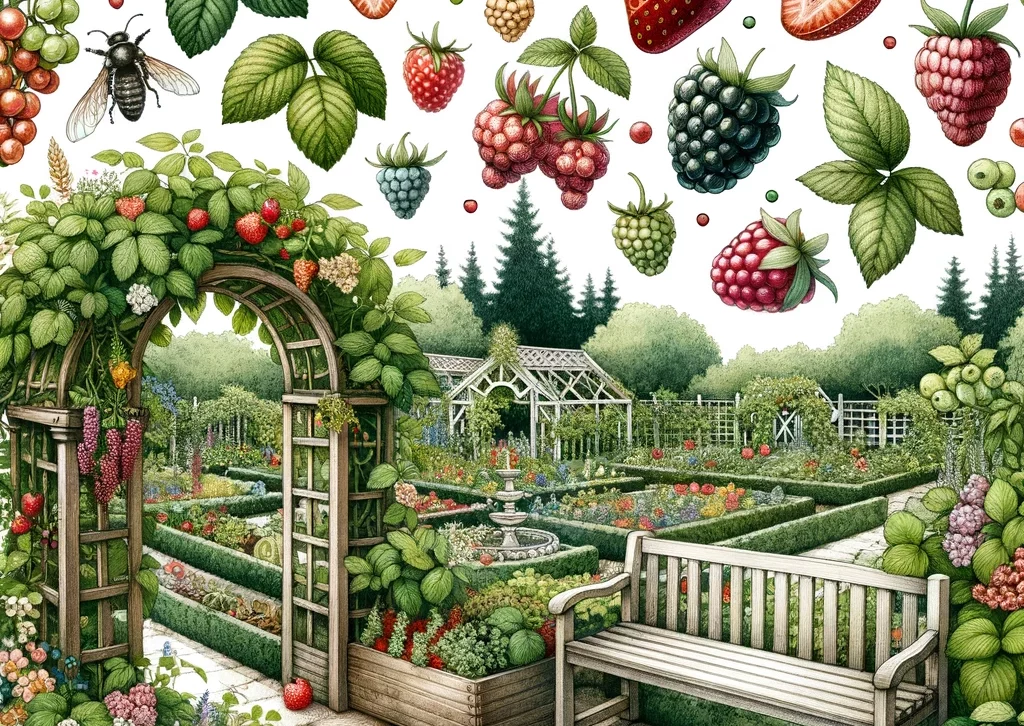
Scandinavian gardens are a treasure trove of unique berries and fruits, adapted to thrive in the region’s cooler climate. From traditional lingonberries to the exotic cloudberry, these gardens offer a cornucopia of flavors and colors. Whether you’re a seasoned gardener or a beginner, this guide will introduce you to the top 10 berries and fruits that flourish in Scandinavian backyards.
Raspberries: The Hardy Choice for Scandinavian Gardens
Varieties of Raspberries
Raspberries are a staple in Scandinavian gardens, offering both visual appeal and a burst of flavor. The two primary types found in this region are red raspberries and black raspberries. While red raspberries boast a vibrant hue and sweet taste, black raspberries are known for their purplish-black color and a more tart flavor profile.
🔗 Discover the Sweet and Tart Flavors of Scandinavian Red and Black Raspberries
Culinary Uses and Nutritional Benefits
These berries are not just for show; they serve multiple culinary purposes. From fresh consumption to the creation of cakes, pies, and jams, raspberries are a versatile ingredient. Nutritionally, they are a low-calorie source of essential nutrients, providing ample fiber, vitamin C, and antioxidants.
Growing Conditions and Tips
Raspberries thrive in well-drained soil with a pH range of 6.0 to 6.5. They prefer full sun but can tolerate partial shade. For optimal growth, consider using organic mulch to retain soil moisture.
Quick Facts
- Color: Red raspberries are bright red, black raspberries are purplish-black
- Flavor: Red raspberries are sweet, black raspberries are tart
- Nutritional Value: High in fiber, vitamin C, and antioxidants
- Uses: Fresh consumption, cakes, pies, jams
- Growing Conditions: Well-drained soil, pH 6.0-6.5, full sun to partial shade
Strawberries: The Versatile Berry for Every Garden
Why Strawberries Thrive in Scandinavia
Strawberries are ubiquitous in Scandinavian gardens, owing to their hardiness and minimal maintenance requirements. These berries are not only easy to grow but also incredibly versatile, finding their way into a myriad of dishes, from desserts and smoothies to salads and jams.
🔗 Strawberries as Groundcover: A Sustainable and Aesthetic Choice
Culinary and Aesthetic Appeal
Strawberries add a pop of vibrant color to any dish, making them a favorite for both culinary and aesthetic purposes. Their sweet, juicy flavor complements a wide range of recipes, while their bright red hue enhances the visual appeal of your garden and your plate.
Growing Tips and Conditions
Strawberries prefer well-drained soil with a slightly acidic pH range of 5.5 to 6.5. They thrive in full sun but can tolerate partial shade. For those interested in sustainable gardening, strawberries also make excellent ground cover, reducing the need for weeding and additional mulch.
Quick Facts
- Color: Bright red
- Flavor: Sweet and juicy
- Nutritional Value: Rich in vitamin C, manganese, and antioxidants
- Uses: Desserts, smoothies, salads, jams
- Growing Conditions: Well-drained soil, pH 5.5-6.5, full sun to partial shade
Apples: A Staple Fruit in Scandinavian Gardens
The Ubiquity of Apples in Scandinavia
Apples are a cornerstone in Scandinavian gardens, celebrated for their versatility and ease of cultivation. These fruits are not just a global favorite but also hold a special place in Scandinavian kitchens, featuring in a variety of culinary applications from juicing and baking to fresh consumption.
🔗 Growing Apples from Seed: My Personal Experience
Varietal Diversity and Harvest Timing
Apples offer a wide range of varieties, each with its unique flavor profile and harvest timing. Depending on the cultivar, apples can be harvested from early to late summer, providing a prolonged harvest season.
Nutritional and Health Benefits
Apples are a nutritional powerhouse, packed with dietary fiber, vitamins, and minerals. They are particularly rich in vitamin C and various antioxidants, making them a healthy addition to any diet.
Quick Facts
- Color: Varies from green to red
- Flavor: Ranges from tart to sweet
- Nutritional Value: High in dietary fiber, vitamin C, and antioxidants
- Uses: Juicing, baking, fresh consumption
- Harvest Timing: Early to late summer, depending on the variety
European Blueberries: A Wild Delight in Scandinavian Gardens
The Rarity and Allure of Homegrown Blueberries
European Blueberries (Vaccinium myrtillus) are a cherished yet uncommon sight in Scandinavian home gardens. While these berries are abundant in the wild, cultivating them in a garden setting offers a unique and rewarding experience.
🔗 Comparing American and European Blueberries: A Comprehensive Guide
Why They Thrive in Scandinavia
These berries are exceptionally hardy, capable of enduring the region’s harsh winters. Their resilience makes them a perfect fit for the Scandinavian climate, where they can produce sweet, antioxidant-rich fruits.
Culinary and Nutritional Highlights
European Blueberries are renowned for their sweet taste and high nutritional value, rich in antioxidants, vitamins, and minerals. They are versatile in the kitchen, finding their way into desserts, jams, and even savory dishes.
Quick Facts
- Color: Dark blue to purple
- Flavor: Sweet with a hint of tartness
- Nutritional Value: High in antioxidants, vitamins, and minerals
- Uses: Desserts, jams, and savory dishes
- Harvest Timing: Late summer to early autumn
Gooseberries: The Hardy Gem of Scandinavian Gardens
The Versatility of Gooseberries
Gooseberries are a quintessential part of Scandinavian home gardens, known for their hardiness and ability to withstand cold temperatures. These berries come in a spectrum of colors, from red and green to yellow and purple, offering both visual and culinary diversity.
🔗 Gooseberries Unearthed: Soil Preferences, Cultivation, and More
Why They’re Perfect for Scandinavia
Their resilience to cold makes them an ideal choice for the Scandinavian climate. Whether you’re a novice gardener or a seasoned horticulturist, gooseberries are relatively easy to grow and maintain.
Culinary Uses and Nutritional Benefits
Gooseberries are known for their sweet-tart flavor, making them versatile in the kitchen. They can be eaten raw, cooked into jams, jellies, and even savory dishes. Nutritionally, they are a good source of Vitamin C and other antioxidants.
Quick Facts
- Color: Red, green, yellow, and purple
- Flavor: Sweet-tart
- Nutritional Value: Good source of Vitamin C and antioxidants
- Uses: Raw consumption, jams, jellies, and savory dishes
- Climate Suitability: Cold-resistant, ideal for Scandinavian climates
Currants: The Tart Delight of Scandinavian Gardens
The Allure of Currants
Currants are small, tart berries that have found a home in many Scandinavian gardens. Their hardy nature and ability to thrive in cooler climates make them a popular choice for gardeners in the region.
Why Currants Are a Scandinavian Staple
These berries come in a variety of colors, including red, white, and black, each offering its own unique flavor profile. The tartness of currants makes them an excellent choice for jams, jellies, and pies, but they also add a zesty kick to salads and sauces.
🔗 Nutritional and Culinary Uses of Scandinavian Currants
Nutritional and Culinary Benefits
Currants are not just a flavorful addition to your garden; they are also packed with nutrients like vitamin C and antioxidants. Their culinary versatility allows them to be used in both sweet and savory dishes, enhancing the flavors and nutritional content of your meals.
Quick Facts
- Color Varieties: Red, white, and black
- Flavor: Tart
- Nutritional Value: High in vitamin C and antioxidants
- Culinary Uses: Jams, jellies, pies, salads, and sauces
- Harvest Timing: Late spring to early summer
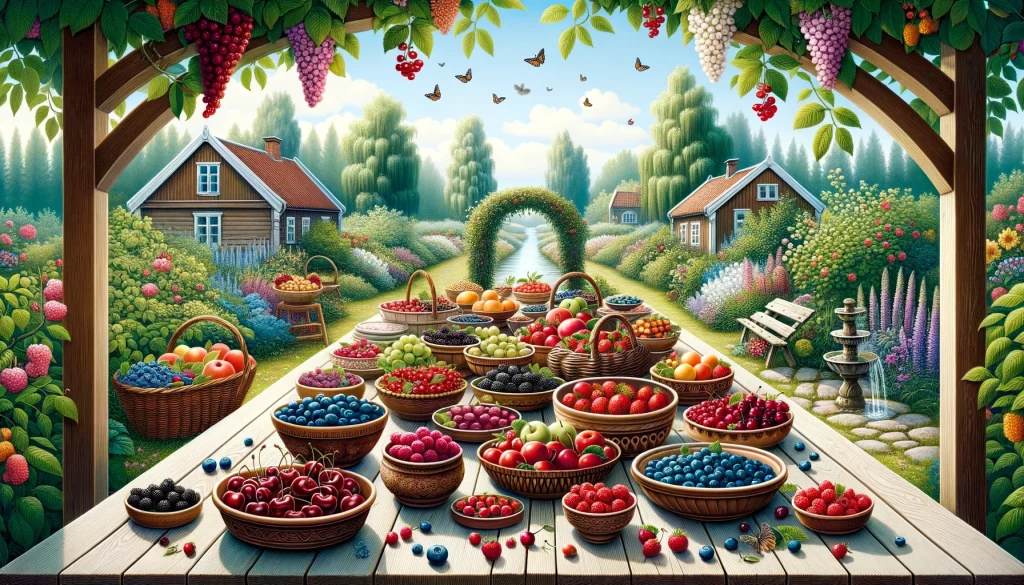
Lingonberries: The Wild Berry with a Cult Following
The Uniqueness of Lingonberries
Lingonberries are a quintessential Scandinavian berry, often foraged from the wild but also possible to cultivate in home gardens. While many Scandinavians enjoy the right to roam and pick these berries in nature, growing them at home can be a rewarding experience.
Why Lingonberries Are Special
Native to Scandinavia, these small, tart, red berries are incredibly hardy and can withstand the region’s cold temperatures. Their versatility extends beyond the kitchen, as they are also known for their medicinal properties, supported by some studies suggesting anti-inflammatory and antioxidant benefits.
🔗 Learn More: How to Grow Lingonberries in Your Own Garden
Culinary and Medicinal Uses
Lingonberries are a staple in Scandinavian cuisine, finding their way into jams, jellies, sauces, and desserts. While they are known to have medicinal properties, it’s essential to note that these claims should be substantiated by credible sources.
Quick Facts
- Color: Red
- Flavor: Tart
- Nutritional Value: High in antioxidants and vitamin C
- Culinary Uses: Jams, jellies, sauces, desserts
- Medicinal Properties: Anti-inflammatory and antioxidant (Source)
Plums: The Versatile Gem of Scandinavian Gardens
Introduction to Plums
Plums are a popular choice for Scandinavian home gardens, not just for their delicious fruit but also for their resilience in colder climates. These hardy trees produce fruit in a variety of shapes, sizes, and colors, ranging from dark purple to yellow.
Why Plums Are a Great Choice
Plums are not just a feast for the eyes and palate; they also offer environmental benefits. For instance, they are excellent for soil stabilization and attracting pollinators.
🔗 Learn More: The Environmental Upsides of Planting Plum Trees
Culinary and Preservation Uses
Plums are incredibly versatile in the kitchen. They can be eaten fresh, dried, canned, or even turned into delicious jams and jellies. Their sweet and tart flavors make them a popular ingredient in both sweet and savory dishes.
🔗 Discover: Plum – The Sweet and Versatile Gem of Your Orchard
Quick Facts
- Color: Varies (dark purple to yellow)
- Flavor: Sweet to tart
- Nutritional Value: High in vitamins and minerals
- Culinary Uses: Fresh, dried, canned, jams, jellies
- Preservation: Can be dried, canned, or frozen
Pears: The Hardy and Versatile Fruit of Scandinavian Gardens
Introduction to Pears
Pears are a staple in many Scandinavian home gardens, offering a delightful blend of sweetness and tartness. These hardy trees are well-suited for colder climates and come in a variety of shapes, sizes, and colors, including yellow, green, red, and brown.
Why Pears Are a Great Choice
Pears are not just delicious; they also play a significant role in local ecosystems. Their masting cycles, for instance, have a ripple effect on wildlife and plant communities.
🔗 Learn More: A Pear Tree’s Journey and Ecosystem Impact
Culinary and Preservation Uses
Pears are incredibly versatile in culinary applications. They can be eaten fresh, canned, or dried and are a great source of dietary fiber. Their subtle sweetness makes them an excellent addition to both sweet and savory dishes.
Quick Facts
- Color: Varies (yellow, green, red, brown)
- Flavor: Sweet to tart
- Nutritional Value: High in dietary fiber
- Culinary Uses: Fresh, canned, dried
- Preservation: Can be canned or dried
Cherries: The Sweet and Tart Delights of Scandinavian Gardens
Introduction to Cherries
Cherries are a delightful addition to any Scandinavian garden, offering both sweet and tart varieties that thrive in the region’s cold climate. These hardy trees not only produce delicious fruit but also add aesthetic value with their vibrant blooms in spring.
Why Cherries Are a Must-Have
Cherries are more than just a tasty treat; they are also relatively easy to grow, even for novice gardeners. Whether you’re interested in making your own jams, pies, or even cherry wine, cherries offer a multitude of culinary possibilities.
🔗 Learn More: How to Grow Your Own Delicious Cherries
Culinary and Preservation Uses
Cherries are incredibly versatile in the kitchen. They can be used in a variety of dishes, from desserts and jams to sauces and beverages. Their sweet and tart flavors make them a popular choice for both sweet and savory recipes.
Quick Facts
- Color: Varies (red, yellow, black)
- Flavor: Sweet to tart
- Nutritional Value: High in antioxidants and vitamins
- Culinary Uses: Fresh, jams, pies, beverages
- Preservation: Can be canned, frozen, or dried
Conclusion: The Bounty of Scandinavian Gardens
A Diverse Palette of Flavors and Nutrients
Scandinavian gardens offer a rich tapestry of berries and fruits, each with its own unique set of flavors, textures, and nutritional benefits. From the tartness of lingonberries to the sweetness of strawberries, these gardens are a testament to the region’s biodiversity and the adaptability of its gardeners.
Sustainability and Local Sourcing
Growing your own berries and fruits not only contributes to sustainability but also allows for local sourcing of high-quality, organic produce. This practice aligns well with the Scandinavian ethos of living in harmony with nature.
🔗 Explore More: Is Hugelkultur in Scandinavia a Good Idea?
A Garden for Every Skill Level
Whether you are a seasoned horticulturist or a gardening novice, the range of berries and fruits discussed in this article offers something for everyone. With the right care and conditions, your Scandinavian garden can become a fruitful oasis, providing both sustenance and aesthetic pleasure.
Final Thoughts
The berries and fruits that thrive in Scandinavian gardens are more than just food; they are a connection to the land, a symbol of the region’s rich natural heritage, and a testament to the resilience and ingenuity of its people.

